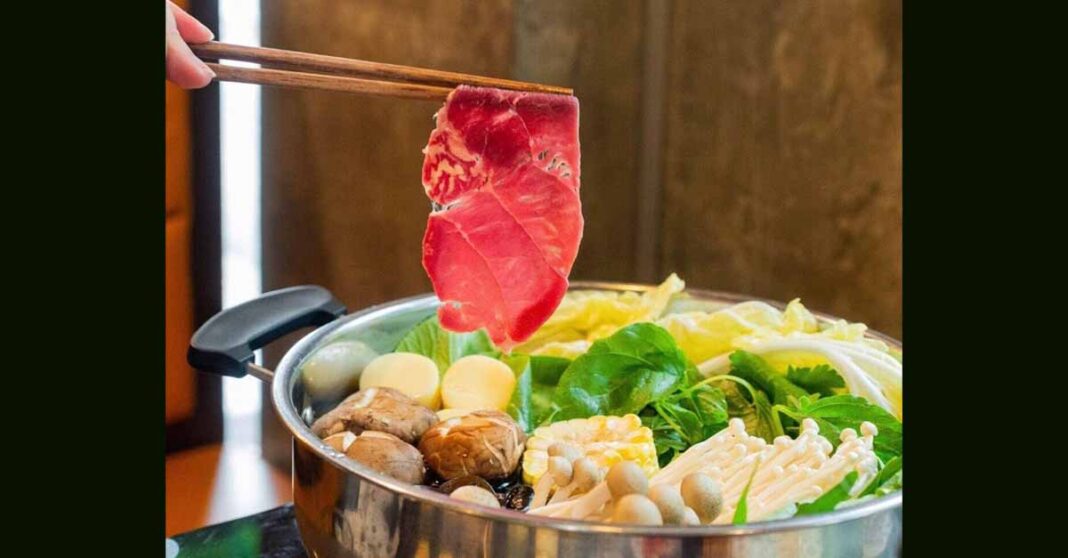What could be better than a pot of bubbling broth, an assortment of fresh ingredients to toss into it, and a group of friends with whom to share it all?
In these days of rapidly rising food costs, we could all stand to branch out and try new restaurants—especially when those restaurants offer delicious local dishes at (mostly) very reasonable prices.
If the term ‘hot pot’ is unfamiliar, you are not alone! This is a uniquely Asian culinary tradition in which a group of friends share a pot of simmering broth and order raw ingredients to add in and cook on the spot. Often, each diner will have their own bowl of dipping sauce to further flavor the cooked meats and vegetables on their way from the simmering liquid and into a hungry mouth.
Let’s take a look at some of the most common varieties of hot pot on offer here in Laos, and get to know this culinary tradition, as well as some of the local restaurants in Vientiane which specialize in it!

Japanese Shabu Shabu
This style of hot pot begins with a typical offering of a large bowl containing one or two flavors of broth, a metal divider separating spicy and non-spicy bases if you just can’t fully commit to either. Shabu shabu, named for the swishing sound of slices of raw beef in hot broth, is known for prominently featuring high-quality cuts of beef, as well as some uniquely Japanese dipping sauces.
Shabu shabu Nangnai is a peaceful little place on the quiet, tree-lined southeastern end of Quai Fa Ngum, opposite Don Chan Palace. Diners can opt for a 90-minute all-you-can eat option for LAK 165,000 per person, or order a la carte from the menu (Lao and English), which offers a good variety of reasonably priced and fresh ingredients. Of particular note, the spicy má là broth has a lovely aroma and flavor, featuring Sichuan peppers, ample fresh chili, and a hint of star anise. The dipping sauces include a delicious Japanese ponzu-style sauce (think sweet rice vinegar with a hint of soy sauce and citrus), as well as a spicy option. The interior is clean, service is attentive, and the beef and mushrooms won’t fail to satisfy.

Lao Sindat
For a truly local-style hot pot experience, sindat is the way to go. Rather than a big bowl of boiling broth, sindat features a central dome-shaped grill surface, encircled by a trough of soup. Diners can choose to grill or boil their food and, after a while, the cooking fat drips down into the soup, creating a rich and oily simmering stock. Most restaurants of this type charge a single all-you-can-eat price, or, if specializing in seafood, charge by the kilo.
Jupdard is a typical Lao sindat restaurant, centrally located on Rue Samsenthai, not far from Bacan Café. The food is a great bargain, with LAK 59,000 per person purchasing unlimited beef, pork, and vegetables, with shrimp also included when fresh and available. While the cuts of meat are delicious and mostly fairly standard, sliced brisket being the typical beef, the menu varies and there are sometimes interesting inclusions. Although organ meats are not generally offered here, a few of the cuts of pork could be a bit unusual for first-timers, such as nom muu, or sow breast (think a cross between bacon and cow udder).
Pro Tip One – Always remember to first rub the grill surface with the fattiest piece of meat to avoid sticking.
Pro Tip Two – Use two pairs of chopsticks per person, one for handling raw meats, and the other for cooked.
Pro Tip Three – The gas heater for your grill-top may need more fuel, and your soup trough may need more soup during the course of a meal; both are added free of charge.
Offering mostly outdoor seating, the street-facing restaurant is large and usually quite crowded, which speaks to the quality and value, as well as its pleasantly rustic vibe. This is a great spot for a casual meal under the stars with friends (and, perhaps, a few cold beers), but be sure to invite a Lao-speaker or prepare to gesticulate well, as there is not much English spoken here.

Chinese Huo Guo
The regional and stylistic variations of hot pot within China are vast, but most famous among them is the Sichuanese variety, which originated the spicy and numbing má là flavor of simmering stock. Another key distinguishing factor of Chinese hot pot is the vast array of options for dipping sauce; the typical preliminary step when eating in such an establishment is to take a small bowl to a sauce counter and fill it with a selection of ingredients, typically including a sesame base, sesame oil, garlic, peppers, herbs, and various fermented pastes, then mix them together to form your own unique dipping blend.
Dong Dong Huo Guo, on a small sidestreet on the way to Wattay International Airport, is probably one of the more upscale hot pot restaurants in the area, so the price is considerably higher than the previous establishments, and diners can only order a la carte. However, the variety and quality of ingredients more than makes up for this, especially if you have a lot of friends along to help split the bill.
The menu (Lao and Chinese only) is available via WeChat QR code, or can be provided on a smart phone. It offers a great variety of simmering stocks, including the deliciously sour and savory tomato base, and the clear and mild mushroom base. The meat selection features very high-end and beautifully marbled “snowflake beef” and delicious cuts of lamb, in addition to more standard varieties of beef, pork, and seafood. Adventurous eaters will also find organ meats in abundance, should they so desire.



